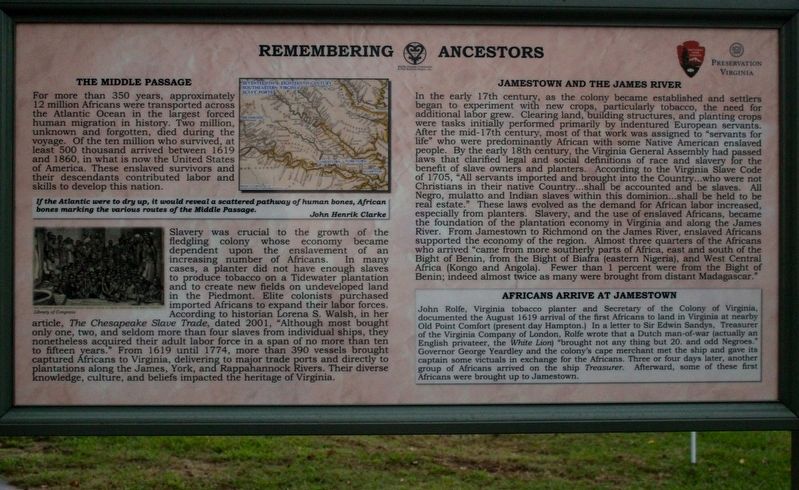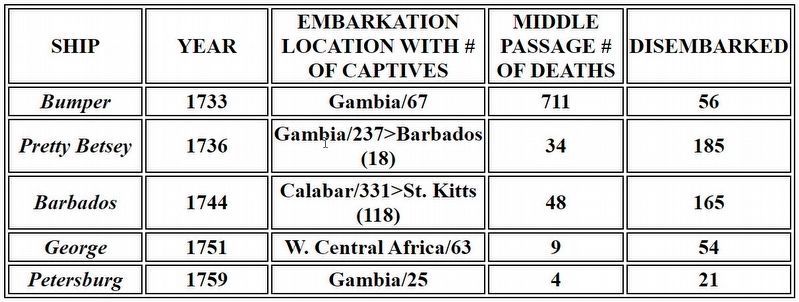Jamestown in James City County, Virginia — The American South (Mid-Atlantic)
Remembering Ancestors

Photographed By John Bloomfield, August 23, 2013
1. Remembering Ancestors Marker
Middle Passage Ceremonies and Port Markers ProjectMbr>
Website homepage:
Click for more information.
Click for more information.
The Middle Passage
For more than 350 years, approximately 12 million Africans were transported across the Atlantic Ocean in the largest forced migration in history. Two million, unknown and forgotten, died during the voyage. Of the ten million who survived, at least 500 thousand arrived between 1619 and 1860, in what is now the United States of America. These enslaved survivors and their descendants, contributed labor and skills to develop this nation.
If the Atlantic were to dry up, it would reveal a scattered pathway of human bones, African bones, marking the various routes of the Middle Passage.
John Henrik Clarke
Slavery was crucial to the growth of the fledgling colony whose economy became dependent upon the enslavement of a increasing number of Africans. In many cases, a planter did not have enough slaves to produce tobacco on a Tidewater plantation and to create new fields on undeveloped land in the Piedmont. Elite colonists purchased imported Africans to expand their labor forces. According to historian Lorena S. Walsh, in her article, The Chesapeake Slave Trade”, dated 2001, “Although most bought only one, two, and seldom more than four slaves from individual ships, they nonetheless acquired their adult labor force in a span of no more than ten to fifteen years.” From 1619 until 1774, more than 390 vessels brought captured Africans to Virginia, delivering to major trade ports and directly plantations along the James, York, and Rappahannock Rivers. Their diverse knowledge, culture, and beliefs impacted the heritage of Virginia.
Jamestown and the James River
In the early 17th century, as the colony became more established and settlers began to experiment with new crops, particularly tobacco, the need for additional labor grew. Clearing land, building structures, and planting crops were tasks initially performed by indentured Europeans servants. After the mid-17th century, most of that work was assigned to “servants for life” who were predominantly African with some Native American enslaved people. By the early 18th century, the Virginia General Assembly had passed laws that clarified legal and social definitions of race and slavery for the benefit of slave owners and planters. According to the Virginia Slave Code of 1705, “All servants imported and brought into the Country…who were not Christians in their native Country…shall be accounted and be slaves. All Negro, mulatto and Indian slaves within the dominion…shall be held to be real estate.” These laws evolved as the demand for African labor increased, especially from planters. Slavery and the use of enslaved Africans, became
the foundation of the plantation economy in Virginia and along the James River. From Jamestown to Richmond on the James River, enslaved Africans supported the economy of the region. Almost three quarters of the Africans who arrived “‘came from more southerly parts of Africa, east and south of the Bight of Benin, from the Bight of Biafra (eastern Nigeria), and West Central Africa (Kongo and Angola). Fewer than 1 percent were from the Bight of Benin; indeed almost twice as many were brought from distant Madagascar.”
(sidebar)
Africans Arrive at Jamestown
John Rolfe, Virginia tobacco planter and Secretary of the Colony of Virginia documented the August 1619 arrival of the first Africans to lad in Virginia at nearby Old Point Comfort (present day Hampton). In a letter to Sir Edwin Sandys, Treasurer of the Virginia Colony of London, Rolfe wrote that a Dutch man-of-war [actually an English privateer, the White Lion] “brought not any thing but 20, and odd Negroes.” Governor George Yeardley and the colony’s cape merchant met the ship and gave its captain some victuals in exchange for the Africans. Three or four days later, another group of Africans arrived on the ship Treasurer. Afterword, some of these first Africans were brought up to Jamestown.
Erected by Middle Passage Ceremonies & Port Markers Project, Inc., Preservation Virginia, National Park Service.
Topics. This historical marker is listed in these topic lists: African Americans • Colonial Era • Settlements & Settlers. A significant historical year for this entry is 1619.
Location. 37° 13.208′ N, 76° 46.041′ W. Marker is in Jamestown, Virginia, in James City County. Marker can be reached from Colonial Parkway, 1.2 miles east of Jamestown Road (Virginia Route 31), on the right when traveling west. Touch for map. Marker is at or near this postal address: 1368 Colonial Parkway, Williamsburg VA 23185, United States of America. Touch for directions.
Other nearby markers. At least 8 other markers are within walking distance of this marker. This land called Tsenacomoco (approx. 0.2 miles away); Colonist on Neck of Land (approx. 0.2 miles away); Neck of Land (approx. 0.6 miles away); Excellent Good Timber (approx. 0.7 miles away); On Roads of Water (approx. 0.7 miles away); Colonial Parkway (approx. 0.8 miles away); Governor Yeardley’s Lot 1620’s (approx. 0.8 miles away); Jamestown (approx. 0.9 miles away). Touch for a list and map of all markers in Jamestown.
Regarding Remembering Ancestors. Although not specifically identified in the Voyages database, Jamestown was one of several settlements (Hampton, Newport News, Norfolk, Portsmouth, Suffolk) only listed as “Lower James.” Historical records, however, indicate that Africans disembarked in Jamestown, which served as the colonial capital for Virginia until 1699. After several devastating fires, the area eventually was abandoned, and the capital moved to Williamsburg.
Sources - Voyages: The Trans-Atlantic Slave Trade Database, Emory University; New Light on the '20 and Odd Negroes' Arriving in VA, William and Mary
Quarterly, 3d. ser., 54 (1997); Central Africans, Atlantic Creoles, and the Foundation of the Americas, 1585-1660, Linda Heywood and John Thornton; Many
Thousands Gone: The First Two Centuries of Slavery in North America, Ira Berlin; Africa and Africans in the Making of the Atlantic World, 1400-1800, John
Thornton; The World They Made Together: Black and White Values i Eighteenth Century Virginia, Mechal Sobel; The Transatlantic Slave Trade and the Making of
the Americas, The Marienrs Museum and the Smithsonian Institution
Also see . . . Middle Passage. Wikipedia entry (Submitted on August 1, 2023, by Larry Gertner of New York, New York.)
Additional keywords. Middle Passage
Credits. This page was last revised on August 1, 2023. It was originally submitted on April 8, 2020, by John Bloomfield of Palm Coast, Florida. This page has been viewed 322 times since then and 33 times this year. Photos: 1, 2. submitted on April 8, 2020, by John Bloomfield of Palm Coast, Florida. • Bernard Fisher was the editor who published this page.
Editor’s want-list for this marker. Wide shot of marker and its surroundings. • Can you help?
